| |
Gerrit S. Miller Jr. Award This award is presented occasionally at the annual North American Symposium on Bat Research to persons in recognition of outstanding service and contribution to the field of chiropteran biology. The award is named after Gerrit S. Miller, Jr., an outstanding early twentieth century bat biologist at the Smithsonian Institution. Miller's work on the evolutionary relationships of chiropteran families and genera to one another still strongly influences taxonomic thinking about bats today. To nominate someone for the Miller Award, see details at NASBR Awards.


Bernal Rodríguez Herrera
University of Costa rica, san josé
2025 - NASBR 53 - Edmonton, canada
Bernal was born in Costa Rica. He studied biology at the University of Costa Rica, and early in his career, he worked as the mammal curator at the National Museum of Costa Rica. He also earned several scholarships from the National Museum of Natural History in Washington, D.C., to collaborate with Dr. Don Wilson. In 1998, his interest in bat ecology led him to the Amazon, where he worked with Dr. Elisabeth Kalko on pioneering research examining the impact of forest fragmentation on bat communities. He continued this collaboration at the University of Ulm in Germany. In 2003, he co-authored Bats of Costa Rica with Dr. Richard LaVal, a landmark reference for the region. He then completed his PhD at UNAM in Mexico under the supervision of Dr. Rodrigo Medellín, focusing on the biology of Ectophylla alba. His work documented, for the first time, the tent-building process by bat—a breakthrough that earned him the Bernardo Villa Award at NASBR in 2007.
Bernal has been a driving force in shaping bat conservation efforts across Latin America. He founded the Costa Rica Bat Program and co-founded RELCOM, the Latin American Network for Bat Conservation, which today connects researchers and conservationists throughout the region. Among his most impactful initiatives is the Central American Strategy for Bat Conservation, a coordinated regional effort for which he received the Whitley Award in 2012. He served as the host of the International Bat Research Conference and NASBR in Costa Rica in 2013. For his lasting contributions to conservation, he has been honored with the Aldo Leopold Award from the American Society of Mammalogists and the Buffet Award from the National Geographic Society.
As a mentor and educator, Bernal has influenced generations of young scientists, participating in bat training courses across Latin America, as well as in Malaysia and Kenya, and guiding students from around the world. He has authored more than 115 scientific publications and two books. His research has significantly advanced understanding of roost ecology—especially in tent-roosting bats—along with plant–animal interactions, seed dispersal by Neotropical bats with an emphasis on stomatochory, animal behavior, and mating systems such as the lek of Centurio senex.
Since 2007, Bernal has been a professor at the University of Costa Rica, where he continues to inspire and mentor new bat biologists. 
 Craig Willis Craig Willis
University of Winnipeg, Canada
2024 - NASBR 52 - Guadalajara, Mexico

 Emma Teeling Emma Teeling
University College Dublin, Ireland
2023 - NASBR 51 - Winnipeg, canada
Emma Teeling is the Full Professor of Zoology at University College Dublin, Ireland and a Co-Founding Director of Bat1K. She grew up in Dublin where she graduated from University College Dublin with a BSc (Hons) in Zoology (1991). She then completed an MSc in Animal Behavior from the University of Edinburgh, Scotland (1996) and studied the captive behavior of the endangered swift fox in Canada. Her PhD was awarded from Queen’s University Belfast (2001) during which she spent two years at the University of California Riverside, USA reconstructing the evolutionary relationships of bats by generating the first large molecular phylogenies. She continued this research during her postdoc at the National Institutes of Health, Maryland USA publishing the first highly resolved bat family-level molecular phylogeny and timetree, which necessitated a revision of our understanding of bat evolution. She returned to Ireland to start her faculty position at UCD (2005), integrating cutting-edge molecular technology with field-based ecology and behavioural studies to uncover the molecular basis of evolutionary novelty and biodiversity, and develop bats as unique model study species. She recognizes the power of leading and integrating diverse researchers and scientific fields to address the grand challenges in science and society. She is the founder and director of the Centre for Irish Bat Research, uniting researchers across the border to study and better conserve Irish bats. She is a founding director of BAT1K, the international consortium of scientists, technologists and bat lovers united to conserve and sequence the genome of all living bats, developing novel genomic methods and concepts, raising funds and inspiring people across the globe to achieve this goal. For the past twelve years she has pioneered the study of wild bats as new models of extended mammalian healthspan uncovering their unique adaptations and collaborating with researchers around the globe, many her former graduate students. As of 2023 she has published >125 research articles, is an elected member of the Royal Irish Academy, has been awarded Chevalier des Palmes Académiques, 2017 by the French Government for her research and given countless high-profile public presentations throughout the globe (e.g. World Economic Forum, TED, European Parliament and European Commission) advocating the amazing biology of bats. 
 Christian VOIGT Christian VOIGT
Leibniz Institute for Zoo and Wildlife Research
Freie Universität Berlin
2022 - NASBR 50 - Austin, TX
Christian C. Voigt is head of the Department Evolutionary Ecology at the Leibniz Institute for Zoo and Wildlife Research (Leibniz-IZW) and Associate Professor at the Freie Universität Berlin. He grew up in Northern Bavaria where he received a diploma and doctoral degree at the University of Erlangen-Nuremberg. For his doctoral degree he worked on the energetics of nectar-feeding bats. His postdoc research at Boston University and Cornell University focused on the sociobiology and olfactory communication of greater-sac-winged bats (Saccopteryx bilineata). After returning to Germany, he became a senior research scientist at the Leibniz-IZW. In 2008, he received his Habilitation at the Humboldt University of Berlin. As of 2022, Christian has published more than 250 papers in scientific journals and edited/co-edited several open-access books on bats, such as ‘Bats in the Anthropocene: Conservation of bats in a Changing World’. He has launched the International Berlin Bat Meeting, which evolved as an influential conference series on newly emerging topics related to bats. His academic work integrates across scales, bridging the cellular, the organismic and the landscape level. Accordingly, he uses a wide variety of methods ranging from behavioural observations to respirometry, stable isotopes and spatial tracking. Nowadays, he is working mostly on questions related to the movement ecology and conservation of bats with a special focus on migratory bats, light pollution and wind energy production. Ultimately, he is interested in transforming human-wildlife conflicts into coexistence. Therefore, besides studying wildlife species he also seeks to better understand the human dimensions of conflicts. Christian is co-editor of two journals and scientific advisor to UNEP/EUROBATS, conservation NGOs and the IUCN Bat Specialist Group. 
 Gerald Wilkinson Gerald Wilkinson
University of Maryland, College Park
2019 - NASBR 49 - Kalamazoo, MI
Gerald (Jerry) S. Wilkinson is Professor of Biology and Associate Dean in the College of Computer, Mathematical and Natural Sciences at the University of Maryland, College Park. He grew up in California where he received a BS in Zoology at the University of California, Davis in 1977 followed by a PhD in Biology at the University of California, San Diego in 1984. After postdoctoral research at the Universities of Sussex, Edinburgh and Colorado, he joined the UMCP faculty in 1987. He was first exposed to bats as a first-year grad student during an Organization for Tropical Studies course. After that course he stayed in Costa Rica to conduct research on a bat-plant system and learned from his advisor, Jack Bradbury, that vampire bats share blood in captivity (reported by Uwe Schmidt at NASBR 1978). That news motivated him to develop a dissertation project on the social organization of vampire bats where he discovered evidence for reciprocal food sharing. He attended his first NASBR in 1979 and has greatly enjoyed many subsequent meetings. His research has involved long-term field and genetic studies on multiple species of New World bats, as well as comparative studies that address a range of topics including cooperation, communication, social learning, social complexity, migration, sexual selection, and longevity. In addition, he has conducted research in Africa and Southeast Asia on stalk-eyed flies, which he helped develop into a model system for sexual selection and genomic conflict. He has advised 21 honors or masters students, 17 doctoral students, and 15 postdocs and enjoys following their careers. He has published over 150 papers and is an elected Fellow of both the Animal Behavior Society and the American Association for the Advancement of Science. 
 Tigga Kingston Tigga Kingston
Texas Tech University
2017 - NASBR 47 - Knoxville, TN
Tigga Kingston is an Associate Professor of Biology at Texas Tech University. Tigga received her BSc (Hons) in Zoology from Royal Holloway University of London (UK) before moving to the US for a PhD in Ecology, Behavior and Evolution at Boston University. Her PhD research focused on diversity, extinction risk, and structure in an insectivorous bat assemblage in Malaysia, which she then expanded to a landscape-scale perspective for her post-doc. Tigga took a position at Texas Tech in 2006 and runs an active lab of international and US PhD students. Tigga attended her first NASBR at the joint meeting with IBRC in Boston in 1995 and has attended regularly ever since. As of 2018, she had authored over 60 scientific publications on bats. Her research centers on the study of bat diversity and the processes that maintain it in intact ecosystems (community ecology), and that influence species loss or persistence in the face of human disturbance (conservation biology). Her work focuses primarily on the insectivorous bats of the Old World tropics (Southeast Asia and Africa); a species-rich group that occurs as highly diverse assemblages in the threatened rainforests and karst systems of the regions. She takes an integrative approach that combines studies of functional, reproductive, landscape, community and microbial ecology to understand community assembly and disassembly in response to anthropogenic changes to habitat. Since Tigga is committed to building scientific capacity in the tropical bat hotspots of the Old World and established and leads a regional network of bat researchers in Southeast Asia (Southeast Asian Bat Conservation Research Union) and serves as the co-Chair of the IUCN SSC Bat Specialist Group with responsibility for the Old World. Human behavior is central to diversity conservation, and more recently her interests have expanded to integrate social and biological components of human-bat interactions that threaten species survival, notably flying fox hunting in SE Asia and West Africa and conflict over fruit crops.

 Sharon Swartz Sharon Swartz
Brown University
2016 - NASBR 46 - San Antonio, TX
Dr. Sharon M. Swartz is a Professor in the Department of Ecology and Evolutionary Biology and in the School of Engineering at Brown University. She received a BA from Oberlin College in 1981, a MS and a PhD in Evolutionary Biology from The University of Chicago in 1985 and 1988 respectively. She moved to Brown in 1990 where she was promoted to the rank of Professor in 2010. She, her students and post docs have a strong record of presentations at NASBR about the biomechanics of flight. Since 1987, she has been an author on over 60 papers, mostly dealing with the flight of bats, but also including fascinating work on the mechanics of tongue operation in Glossophaga soricina. She leads a group of biologists and engineers who consistently present us with a different perspective about the operations of bats. It is significant that undergraduate students often are co-authors on her published papers and other contributions. Her presentations are clear and effective. She has a great talent for making biomechanics readily accessible to non-specialist audiences. She also takes pains to involve members of her laboratory in these exercises, whether locally or abroad. In the field, she works well with others whether colleagues or students. She sets high standards for herself and for others and establishes a positive, stimulating and supportive environment. In addition to her role as a researcher and supervisor of student research, Sharon has contributed strongly to the teaching function of the university as well. In 2013 she received the Distinguished Alumni Service Award from the University of Chicago and in 2012 she was a featured researcher in the Air Force Office of Scientific Research 60th anniversary video. NASBR was proud to award her the 2016 Gerrit S. Miller Jr. Award.

 Betsy Dumont Betsy Dumont
Amherst University
2014 - NASBR 44 - Albany, NY
Betsy Dumont is a Professor of Life and Environmental Sciences and Dean of the School of Natural Sciences at University of California Merced. She received her BA from Indiana University Bloomington and Ph.D. from Stony Brook University in 1993. All of her degrees were in physical anthropology but she saw the light and delved into the world of bats soon after finishing her Ph.D. Her research program centers on understanding the evolution of diversity in form and function through synthesizing information about animal behavior, ecological and biomechanical performance, and ecology within an evolutionary context. This allows her to identify associations between form and function as well as to investigate macroevolutionary processes that underlie the evolution of diversity. As a direct result of her efforts and those of her students and collaborators, the form, function, and evolution of skull form, feeding behavior, and feeding performance in bats is among the most well-studied of all mammals. More recent work has shifted toward large-scale analyses that seek to identify mechanisms underlying the evolution of groups of species that display diverse anatomical forms and fill a broad array of ecological niches. She has had the good fortune of conducting fieldwork in Costa Rica, Panama, Mexico, Australia and Papua New Guinea. She and her students have been attending NASBR meetings since 1995. During that time she served as a member and Chair of the Student Prize Committee and Board of Directors.

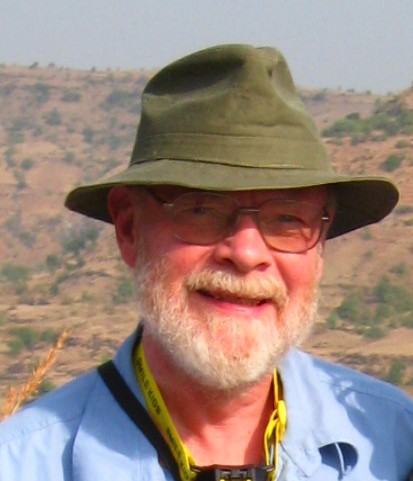 James Simmons James Simmons
Brown University
2013 - NASBR 43 - San Jose, CR
James A. Simmons received a G.S. Miller Award for his excellent work on bat echolocation. After an A.A. at Union Jr. College, a B.A. at Lafayette College, a M.A. and Ph.D. at Princeton University, Jim became a Professor at Washington University and later a Professor in the Department of Neuroscience at Brown University. His 130+ publications included some of the most fundamental findings on how bat echolocation works. He carried on the traditions of Spallanzani and Griffin, bringing bats into the laboratory and training them in various tasks, designed to reveal more details about the diversity of bats’ echolocation behaviour. In addition to a long history of laboratory work, Jim also studied bats and their echolocation in the field. The findings of Jim and his students have greatly advanced our understanding of what bats can do with echolocation. In these endeavours, he has always engaged others in discussions and interactions which further enriched our knowledge of echolocation. The combination of laboratory and field work was fundamental to his success because he was able to interpret laboratory findings in a natural context. Attendees at NASBR meetings benefitted greatly from hearing Jim’s presentations about the latest findings in echolocation. One of the most memorable was the 2002 session on echolocation which involved papers from both Griffin and Simmons.

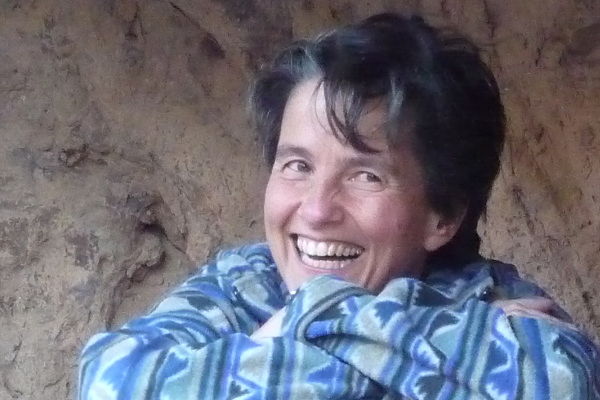 Elizabeth Kalko (1962-2011) Elizabeth Kalko (1962-2011)
University of Ulm
Awarded posthumously 2011 - NASBR 41 - Toronto, ON
Elisabeth Kalko was a passionate ecologist who worked on questions of tropical biodiversity, particularly on bats. She was one of the most prominent experts in the areas of bat community ecology, echolocation, and behaviour. Elisabeth did her Masters and Doctoral degrees with Uli Schnitzler at the Tübingen University on the echolocation of European bats. After this start in science, she received a NATO fellowship and went to the Smithsonian Institution in Washington to work with Charles Handley, a well-known mammalogist. He was the one to introduce Elisabeth to the tropical bats at Barro Colorado Island, Panama, the field station of the Smithsonian Tropical Research Institute (STRI). Over the following years she worked at STRI on a wide range of physiological and ecological questions. She is most widely known for her advances in the study of echolocation and for increasing our understanding of biodiversity and species co-existence. Elisabeth pioneered the use of echolocation recordings for complementing bat surveys in the tropics. A famous quote of hers was “There is only one thing that is better than a sound recording: MANY sound recordings!” In 2000 she was appointed head of the Institute of Experimental Ecology at the University of Ulm but continued to work also as a Staff Scientist at STRI in Panama, which continued to be her favorite study site over the following decade. She also expanded her studies to other regions including Costa Rica, Mexico, Brazil, Ivory Coast, Tanzania, and Ghana. Over the years she continued to work on topics of bat sensory ecology, but she also became interested in the ecology of bat-borne viruses. One of her special qualities was her unique combination of cutting-edge scientific methods with a very broad understanding of natural history. She published more than 100 scientific papers and mentored many students. She was the focus of several documentary films. As she knew education to be key to the general acceptance of conservation, she gave many public presentations on biodiversity and particularly on her favorite bats.

 Gareth Jones Gareth Jones
University of Bristol
2011 - NASBR 41 - Toronto, ON
Gareth Jones is Professor of Biological Sciences at the University of Bristol, U.K. Gareth received his B.Sc. (Hons) from the University of London before completing a Ph.D. on the behavioural ecology of birds at the University of Stirling. He then started life in Bristol as a Royal Society University Research Fellow. Some of Gareth's key achievements include leading research on the discovery of a new, abundant species of European bat, the first mammal species to be described from Britain in recent years; being involved in the discovery of 3 further cryptic species of bat, and driving research on how cryptic species contribute to bat biodiversity worldwide; elucidating unusual social organisation (matrilineal structure and intra-lineage polygyny) in bats; determining when echolocation is ineffective for bats, and elucidating how moths respond to echolocation calls of bats; pioneering methods for the acoustic identification of bats and the development of acoustic monitoring; leading research on potential adverse effects of street lighting on bats, triggering wider interest in negative effects of lighting on animals; using presence-only modelling to predict bat distributions and to predict responses under climate change scenarios; producing some of the first papers using molecular methods to identify insect prey eaten by bats and building capacity for bat research in China and India, leading to research on genes involved in vocalization and hearing in echolocation. Gareth has supervised over 40 Ph.D. students to completion, many of whom are academics in universities throughout the world, and is author of more than 270 peer-reviewed articles. He is now primarily interested in conservation biology, and works on a wide variety of taxa.

 Wieslaw Bogdanowicz Wieslaw Bogdanowicz
Museum and Institute of Zoology PAS, Poland
2010 - NASBR 40 - Denver, CO
Wieslaw Bogdanowicz is a Full Professor at the Museum and Institute of Zoology of the Polish Academy of Sciences (PAS), Warsaw, Poland. His scientific career started at the beginning of the 1980s at the Mammal Research Institute PAS in the middle of the primeval forest in Bialowieza. Initially, he was much interested in relationships between morphology (incl. geometric morphometrics), phylogeny and evolution of bats. His PhD, which was awarded by the Jagiellonian University in Cracow, focused on the morphology and taxonomy of Daubenton’s bat in Europe. His next scientific degree, habilitation, was defended at the Institute of Systematics and Evolution of Animals PAS in Cracow. It was devoted to phenetic and phylogenetic relationships in the family Rhinolophidae. Of high importance are also his studies on bat diet (incl. a metagenomic approach) and connections between skull and wing, and echolocation. He was a fellow of Fulbright (USA) and Alexander von Humboldt (Germany) Foundations. He is a winner of the Gerrit S. Miller Jr. Award (USA, 2010) “in recognition of outstanding service and contribution to the field of chiropteran biology ”. In 1999 he established Acta Chiropterologica — the only journal fully devoted to bats, which is indexed by Thomson Scientific. However, Wieslaw’s interests are very broad. He was a co-editor of The Atlas of European Mammals (Poyser, 1999) and The Polish Fauna (five volumes since 2004). Presently, his work is based mainly on genetics and genomics. He explores contemporary and ancient DNA of various organisms, including flies of forensic significance, bats (analyses of 4,300 year old guano, their diet at wind farms, family-relationships, connections between rabies and population genetics), carnivores, and humans (incl. the famous astronomer Nicolaus Copernicus). In 2019 he was elected a member of the IUCN Canid Specialist Group.

 Robert J. Baker (1942-2018) Robert J. Baker (1942-2018)
Texas Tech University
2009 - NASBR 39 - Portland, OR
Robert Baker was a Professor in the Department of Biological Sciences at Texas Tech University in Lubbock, Texas. He received a B.S. from the Arkansas A&M College in 1963, an M.S. from Oklahoma State University in 1965 and a Ph.D. in Zoology from the University of Arizona in 1967. From Arizona, Robert moved directly to a faculty position at Texas Tech University, where he spent his entire career. After moving through the normal academic progression from Assistant to Full Professor, he was named Horn Professor in the Department of Biological Sciences (1979), and he also held positions as Director, Natural Science Research Laboratory (from 1976), Curator of Mammals, and Curator of Genetic Resource Collection, Museum of Texas Tech University. He began attending NASBR early on and participated fairly regularly until retirement. Robert was an amazingly productive scientist, attested by his authorship of 438 scientific publications, with more still appearing regularly. Most of those were on bats, and he described 2 subfamilies, 2 tribes, 4 subtribes, 1 genus, 2 subgenera, 15 species, and 2 subspecies during his career. Robert’s lab at TTU always focused on fieldwork and the collection of voucher specimens to accompany all phases of lab work that might follow. After a developmental leave in 1986 working with Rodney Honeycutt (a former student of his) at Harvard University, his early focus on karyology branched out to include a variety of molecular techniques over the years, including in situ hybridizations, G and C chromosomal banding, starch gel electrophoresis, restriction enzyme mapping, DNA sequencing, construction and probing of cosmid and plasmid libraries, and differential expression of genes. To collect the specimens necessary to do the molecular work, Robert worked in Mexico, Guatemala, El Salvador, Honduras, Nicaragua, Costa Rica, Panama, Colombia, Venezuela, Suriname, Ecuador, Peru, Trinidad, Grenada, Dominica, Guadeloupe, Montserrat, Puerto Rico, Jamaica, Cuba, Tunisia, England, Ukraine, Russia, and the U.S. During his tenure, Robert saw the mammal collection at TTU grow from about 5,000 to almost 120,000. Working with students was always a major focus for Robert, and he supervised more than 50 Master’s and 50 Ph.D. students over the years. Robert was very active in the American Society of Mammalogists (ASM), where he served as President from 1994-1996. In 1980 he received the C. Hart Merriam Award, the H.H.T. Jackson Award in 1994, and the Joseph Grinnell Award in 2000. In 2008, he was elected to Honorary Membership in ASM. A recent obituary listed more than 25 awards received by Robert during his career.

 Nancy Simmons Nancy Simmons
American Museum of Natural History
2008 - NASBR 38 - Scranton, PA
Nancy Simmons is the Curator-in-Charge of the Department of Mammalogy at the American Museum of Natural History, and a Professor in the AMNH’s Richard Gilder Graduate School. She received her BA from Pomona College in 1981 and her Ph.D. from U.C. Berkeley in 1989. She was lucky enough to be awarded a postdoctoral fellowship at the AMNH after graduation, and joined the permanent staff there in 1991. Her research focuses on morphology, systematics, and evolution of bats. She works with both living and fossil species, and is interested in phylogenetic relationships, biogeography, evolution of ecological diversity, community structure of Neotropical bat faunas, and everything having to do with bats in Belize. A morphologist by training, her students and collaborators have pulled her into many new research areas in recent years including bat ecology, genome/pheonome connections, bat ectoparasites and microbiomes, disease dynamics, and conservation biology. She conducts fieldwork yearly in the Neotropics but has also worked in Southeast Asia. She recently joined the Board of Directors of Bat Conservation International, and serves as the as Chair of the Global Bat Taxonomy Working Group of the IUCN Bat Specialist Group. She is also on the Steering Committee for SEABCRU (Southeast Asian Bat Conservation Research Union) as well as the Steering Committee for Taxonomy and Collections for the Bat 1K Project.

 R. Mark Brigham R. Mark Brigham
University of Regina
2006 - NASBR 36 - Wilmington, NC
Mark Brigham is a Professor of Biology at the University of Regina in Regina, Saskatchewan Canada. He received a B.Sc. from Queen’s University (Kingston) in 1983. Both of his graduate degrees were supervised by Brock Fenton, an M.Sc. in Biology from Carleton University in 1985 and a Ph.D. in Biology from York University in 1988. After a Post-doc in Calgary working with Robert Barclay, he took up his position in Regina in 1990. He attained the rank of Full Professor in 2000. He attended his first NASBR in Fort Collins, CO in 1983 and has with a number of students participated almost every year since where he has been known to give the occasional talk on feathered bats, namely nightjars. He is currently the Secretary of the Miller Award holders. As of 2017, Mark had authored over 170 scientific publications. He has supervised more than 50 graduate student projects. He is the recipient of University of Regina awards for Undergraduate Teaching, Public Service and Graduate Student Mentorship. He was the first Canadian to receive (2008) the Joseph Grinnell Award from the American Society of Mammalogists. Aside from research and teaching which he loves, he plays hockey, badminton, golf and curling. He enjoys the physical aspects as well as the social and does love to compete. The sport helps offset the fact that he really enjoys food and is married to a wonderful cook (Anne, for nearly 35 years). He loves conversation, especially over a glass or maybe two of a full-bodied Barossa Shiraz, a Stellenbosch Pinotage, an Okanagan Valley Riesling or an Uco Valley Malbec.

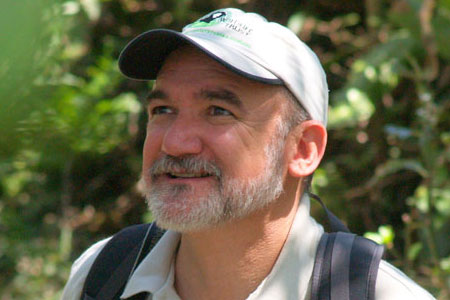 Rodrigo Medellin Rodrigo Medellin
Universidad Nacional Autonoma de México
2004 - NASBR 34 - Salt Lake City, UT
Rodrigo A. Medellín is a conservation biologist and professor at the Instituto de Ecología at the National Autonomous University of Mexico known for his work in the conservation of bats and other mammals. Rodrigo has been recognised for his leadership in creating positive change for people or the world around us; in 2004 he received the Miller Award in recognition of his excellent conservation-relevant work on bat diversity and ecology as well as his mentorship, teaching, and outreach. His contributions to conservation led him to receive, that same year, the National Nature Conservation Award from the President of Mexico, and he was also the second recipient of the international Whitley Award, which recognizes outstanding grassroots conservation leaders and has been called “The Green Oscars”. A year later, Rodrigo created the non-profit Bioconciencia which promotes the conservation and recovery of biological diversity in Mexico. Many years after receiving the Miller Award, Rodrigo continues to greatly expand his impact on bat conservation. In 2012, after years of conservation work, Rodrigo collected the data necessary to remove the Lesser Long-nosed bat Leptonycteris yerbabuenae, from the endangered species list, which marked the first time a Mexican species has been delisted and stands as a testimony to effectiveness of conservation programs. That year, he was the first-ever recipient of the new Whitley Gold Award, and became the focus of a BBC documentary film titled The Bat Man of Mexico. He has collaborated with the American Museum of Natural History, has been an ambassador for the International Union for Conservation of Nature, President of the Society for Conservation Biology and Co-Chair of the CITES Animals Committee, the IUCN Bat Specialist Group, and the Founding Director of the Latin American Network for Bat Conservation. Most recently, Rodrigo is helping create the Global South Bats, a network of bat conservationists whose mission is to exchange knowledge, build capacity and join forces to solve today's most pressing conservation matters in Africa, Asia, and Latin America. Rodrigo has made substantial impacts on how people perceive bats through rigorous science, engaging outreach, and well-designed education programs.

 Robert M. R. Barclay Robert M. R. Barclay
University
2002 - NASBR 32 - Burlington, VT
Robert M.R. Barclay received a G.S. Miller Award in 2002 in recognition of his significant contributions to our knowledge of the behaviour and ecology of bats. Robert was one of the first to use playback presentations of echolocation calls in the field to demonstrate the communication role of these signals. At field sites in Manitoba, Robert and his students obtained detailed data about hoary bats, eastern red bats and silver-haired bats. These studies provided information about migration and habitat use, as well as foraging behaviour. Other contributions produced important findings about bats and forests, and the impact of urbanization on some bats. He has worked with a variety of species and addressed a variety of questions (e.g., sensory biology, echolocation, behaviour, predation, foraging, prey selection, energetics, reproduction) during >40 years of conducting research. He has also supervised students working on other organisms such as kangaroo rats, swallows, poorwills and swans). He is as excited about the research of an undergraduate student doing a special topics project as he is about a postdoctoral fellow whose principal focus is research. He fully appreciates the balance between allowing students do things for themselves and learning from their mistakes, while providing them with guidance and encouragement.

 Patricia W. Freeman Patricia W. Freeman
University of Nebraska
2001 - NASBR 31 - Victoria, BC
P.W. Freeman is Professor Emerita at the University of Nebraska-Lincoln, and Curator of (Vertebrate) Zoology, University State Museum where she taught courses in general zoology, vertebrate zoology, functional morphology, mammalogy, and museum studies. Trish graduated Randolph-Macon Woman’s College in Lynchburg VA with an AB in Biology in 1969 and in 1977 received her PhD from University of New Mexico in Albuquerque. Between degrees she was Scientific Assistant in the Department of Mammalogy, American Museum of Natural History in New York where her mentors were Richard Van Gelder, Sydney Anderson, Karl Koopman, Guy Musser, Hobart Van Deusen, and paleomammalogist, Malcolm McKenna. There her interest in evolution and form and function rose to the level of seeking a graduate degree. Freeman received her PhD from James S. Findley, where she used morphometrics to resolve systematic, natural history, and evolutionary questions in molossid bats. She was especially interested in finding natural morphological groupings of species. Further, certain molossids with robust skulls and teeth divided the insect community by eating harder insects such as beetles in contrast to others with gracile skulls and jaws that ate softer prey such as moths. After her PhD Freeman was Assistant Curator and Head of Mammals at Field Museum of Natural History in Chicago. She oversaw renovation and move of collections into new quarters. She won substantial funding to complete the project before she left for the University of Nebraska-Lincoln in 1981. Freeman quantified transitions at the tooth-food interface of insectivorous bats to those with derived diets of vertebrates, fruit, pollen, nectar, and blood. She proposed how Phyllostomid bats with their diverse diets may have evolved. She experimentally quantified forces that actual and fabricated teeth made during indentation and puncturing as well as forces taken to cut through a diversity of fresh insects. She and a colleague devised a field technique to measure bite force of living bats and rodents with field work locally and in the neotropics. Before retirement in 2015 she and colleagues studied distributions and migratory movements of Myotis septentrionalis, the arrival of white-nose syndrome into Nebraska, and subsequent reduction of that species in the state. She found microhabitat availability outside traditional caves/quarries in winter and summer roosts by netting, acoustics, and radio-tracking. Freeman was an active member of the American Society of Mammalogists, was awarded the 1974 Shadle Fellowship, served on committees including Associate Editor for the Journal of Mammalogy. She was also active in NASBR on committees, board of directors, and hosted bat meetings in Lincoln in 1990 and 2003. In 2001 Trish was awarded the Gerritt Miller for her contributions to bat biology. In 2017 a newly discovered molossid bat netted in Panama was named for her: Cynomops freemani, Freeman’s dog-faced bat.

 Theodore H. Fleming Theodore H. Fleming
University of Miama
1999 - NASBR 29 - Madison, WI
Ted retired from the University of Miami in 2008 and lives in Tucson, AZ. He received a BA from Albion College in 1964 and a MS and PhD from the University of Michigan in 1968 and 1969, respectively. He was an Assistant and then an Associate Professor of Biology at the University of Missouri-St. Louis in 1969-78. He joined the Department of Biology, University of Miami in 1978 and was promoted to Full Professor in 1980. Ted is well-known for his pioneering work on ecological interactions between plant-visiting phyllostomid bats and their food plants. He and his students presented many of their research results at NASBR meetings from the early 1970s until 2009. He initially studied rodent and bat populations in Panama in 1966-67. He and his students studied frugivore-fruit interactions in Costa Rica from 1970 to 1986. His group then studied nectar bat-cactus flower interactions, primarily in northern Mexico, from 1989 to 2000. He finished his major research by studying the evolution of three lineages of West Indian phyllostomid bats in 2000-2006. In addition to publishing over 150 papers, chapters, reviews, etc., he has authored/co-authored/edited nine books. Five edited books helped to synthesize four research fields: fruits and frugivores, columnar cacti and their mutualists, island bats, and most recently, the adaptive radiation of phyllostomid bats. Two of his books (‘A Batman in the Tropics’ and ‘No Species is an Island’) were written for a general audience, and, along with co-author W.J. Kress, he synthesized the entire field of ecological and evolutionary interactions between tropical vertebrate nectarivores and frugivores and their food plants in ‘The Ornaments of Life.’ During his career, Ted received several awards: AAAS Fellow, Senior Fulbright Fellow, NSF Mid-career Fellow, G.S. Miller Jr. Award, the C. Hart Merriam Award (American Society of Mammalogists), and a Distinguished Alumni Award from Albion College. In retirement, he is involved in a citizen science project studying the use of hummingbird feeders by nectar bats in southern Arizona and is a serious amateur photographer specializing in wildlife and ‘people doing interesting things.’ He has been married to Marcia Strandberg for over 50 years, and they have two grown children and two grandchildren.

 Gary F. McCracken Gary F. McCracken
University of Tennessee
1997 - NASBR 27 - Tuscon, AZ
Gary McCracken is Professor of Ecology and Evolutionary Biology at the University of Tennessee, Knoxville. He received a B.S. in Biology from the University of Notre Dame in 1970, and completed his Ph.D. on the population biology and breeding systems of the white-lipped land snail at Cornell University in 1976. Gary’s introduction to bats (besides catching one in a butterfly net at the Syracuse NY Airport) began in 1976 when he accepted a post-doctoral fellowship working with Jack Bradbury on the social behavior of the Greater Spear-nosed Bat (Phyllostomus hastatus) in Trinidad, West Indies. Although he did a subsequent post-doc on breeding systems of land mollusks, and retains abiding interests in land snails and slugs, his time with P. hastatus, and the community of bat researchers that he met at his first his first NASBR meeting in Albuquerque, N.M. in 1978, convinced Gary that bats were the system on which he should mostly work. Since then, Gary has attended almost every NASBR meeting and hosted the meetings in 1989 and 2018. Throughout his career, Gary has followed behind molecular biologists to pick up genetic techniques that can be applied to field research to investigate what he sees as interesting questions in evolution, behavior and ecology. Early on his research coupled intensive field research with the application of genetic markers to investigate mating systems, relatedness, and social behavior in bats. He has had a long-time relationship with the amazing Brazilian free-tailed bat (Tadarida brasiliensis) that has led him, his students, post-docs, and colleagues to investigate mother-pup nursing relationships and communication in nursery crèches. Later work with these bats has investigated high altitude foraging and flight behaviors, links to insect migrations, and the ecosystem services that bats provide by reducing insect pest populations, damage to crops, and the need for pesticides. All of his best ideas have come from reading the literature, and his best work has been done in collaboration with amazing students and colleagues. Gary has supervised 32 graduate students, many of whom are active with NASBR, and is author of over 150 scientific publications. Much of his current effort is directed toward the conservation of bats and their habitats.

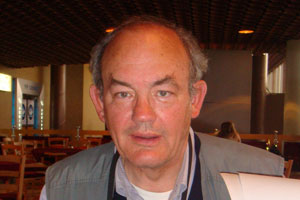 Paul A. Racey Paul A. Racey
University of Aberdeen
1995 - NASBR 25 - Boston, MA
After graduating from Cambridge University, Paul’s work on bats began in a research institute in London Zoo in 1966 with a brief to breed British bats in captivity and unravel the mysteries of their reproduction, particularly sperm storage. After a PhD from the University of London and a postdoc at The Unit of Reproductive Biology, University of Liverpool, he moved to Aberdeen University where he remained for the rest of his career. He retired as Regius Professor of Natural History in 2009 and migrated 700 miles southwest to the warmer climate of Cornwall where he is now an Honorary Visiting Professor at the Centre for Ecology and Conservation, Cornwall campus of the University of Exeter. At Aberdeen he established a research group working on bat ecology, energetics, molecular genetics and finally on the ecology and conservation of Malagasy bats. In 1985 he organised the Seventh International Bat Research Conference together with the European Bat Research Symposium. He co-founded the UK’s Bat Conservation Trust and in Madagascar the NGO Madagasikara Voakajy. He has supervised 50 PhD students, half of them working on bats. He has authored and co-authored about 500 publications – mainly primary research papers but also book chapters, edited books and two conservation Action Plans. Before he retired, he and his students were regular attenders at NASBR which he considered to be the best of the bat meetings. He was awarded the UK Mammal Society’s Silver Medal and a Lifetime Achievement Award and Honorary Life Membership of the Bat Conservation Trust. He is also an Honorary Member of the American Society of Mammalogists.

 Don. E. Wilson Don. E. Wilson
National Museum of Natural History
1992 - NASBR 22 - Sherbrooke, QC
Don Wilson is Curator Emeritus in the Division of Mammals at the National Museum of Natural History in Washington, D.C. He received a B.S. from the University of Arizona in 1965, an M.S. and a Ph.D. in Biology from the University of New Mexico in 1967 and 1970 respectively. After a Post-doc in Costa Rica with Dan Janzen, he moved to the Smithsonian in 1971 where he worked until retirement in 2011. He attended the second NASBR in Albuquerque in 1971, and participated regularly until retirement. Don is the author of 261 scientific publications including books on the Mammals of New Mexico, three monographs on bats, three volumes on Biodiversity, and two editions of Mammal species of the World. In 1997, he published Bats in Question - The Smithsonian Answer Book. In recent years, he has edited a series of books for the Educational Publisher, Dorling Kindersley, including Animal, Human, the Smithsonian Handbook of Mammals, and Mammal. He also wrote a field guide to North American mammals and the Smithsonian Book of North American Mammals. He is currently editing the Handbook of Mammals of the World, with 7 volumes published and 2 to go, including the final one on bats. He has given over 100 papers at scientific meetings. His research on bats has taken him to more than 70 countries around the world. He is the recipient of a Smithsonian Institution Award for Excellence in Tropical Biology, a U.S. Fish and Wildlife Service Outstanding Publication Award, a Reconocimiento for Outstanding Contributions to Science from the Associacion Mexicana de Mastozoologia, the Gerritt S. Miller Award from the North American Symposium on Bat Research, and the Hartley H. T. Jackson Award of the American Society of Mammalogists. In 2002 he received the American Society of Mammologists’ highest award: Honorary Membership. In 2016 he was also awarded Honorary Membership in the Ecuadoran Mammal Society.

 Bernardo Villa-Ramirez (1911-2006) Bernardo Villa-Ramirez (1911-2006)
Universidad Nacional Autonoma de México
1990 - NASBR 20 - Lincoln, NE
Bernardo Villa Ramírez (1911 –2006) was a pioneer in the study of bats in Mexico. Born in Teloloapan, Guerrero, Villa Ramírez studied in Guerrero and then Mexico City, returning to his rural hometown to build a school and become a teacher. He later attended the National Autonomous University of Mexico (UNAM). In 1947, he obtained a master’s at University of Kansas, and in 1966, he became the first researcher in Mexico to obtain a doctorate degree specialized in mammals from the National Autonomous University of Mexico (UNAM). He focused his research especially on bats. He published over 140 research papers and seven books, and trained over 70 undergraduate and graduate students in research. His book, Los murcielagos de Mexico, became a standard reference for Mexican bat researchers. His memberships and service in scientific societies include an honorary life membership in the American Society of Mammalogists, a president and honorary life member of the Mexican Association of Mammalogy, and first president of the Mexican Society for Marine Mammal Research. The North American Society for Bat Research honors his legacy through the Bernardo Villa Award.

 Merlin D. Tuttle Merlin D. Tuttle
Bat Conservation International
1986 - NASBR 16 - Amherst, MA
Merlin Tuttle obtained his Ph.D. with honors at the University of Kansas, served as Curator of Mammals at the Milwaukee Public Museum, published extensively on population ecology and behavior of endangered gray bats and on behavior of frog-eating bats. He wrote two books, founded and led Bat Conservation International for nearly 30 years, participated in all 46 meetings of NASBR and has been a leading spokesman for bat conservation. His photography, featured in five articles in National Geographic and in countless other publications, has provided a firm foundation for conservation efforts worldwide. He has lectured at most of America’s leading institutions, and has received numerous awards, including The Gerrit S. Miller, Jr. Award, The Society for Conservation Biology’s Distinguished Achievement Award and The National Fish and Wildlife Foundation’s Chuck Yeager Award. He retired from leadership at Bat Conservation International in 2009 and founded Merlin Tuttle’s Bat Conservation in 2014. He continues a full-time schedule of international travel and photography on behalf of bats.

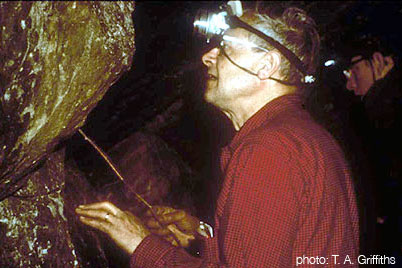 Harold B. Hitchcock (1903-1995) Harold B. Hitchcock (1903-1995)
Middlebury College
1986 - NASBR 16 - Amherst, MA
Harold B. Hitchcock (1903 – 1995) received a G.S. Miller Award in 1986 in recognition for his pioneering work on seasonal movements of bats (mainly Myotis lucifugus) in New England. Hal had been a faculty member at the University of Western Ontario (1939-1943) when he moved to Middlebury College in Vermont. At Middlebury he served as Chair of the Department of Biology and then retired in 1968. After retirement he also held visiting professorships at Boston University (summer 1968), at Norwich University (fall 1968), and the University of Hawaii (1969). Then, from 1969 until 1972 he served as Chair of the Department of Biology at Bates College. In 1971 he taught a six week long course on bat banding, taking six undergrad students to many sites in New England and adjacent Canada. Tom Griffiths was one of the six students. Hal Hitchcock was an active researcher and teacher, whose interests were many and varied. His commitment to biology, and especially the study of bats was exemplary and is reflected by his records of employment, and by his publications. Fifty years later, bats still use many of the sites in Ontario where Hal had banded bats, Craigmont mine, Tyendinaga Cave, Puzzle Lake Cave the most notable.

 Thomas H. Kunz (1938-2020) Thomas H. Kunz (1938-2020)
Boston University
1984 - NASBR 15 - Rockford, IL
Tom Kunz was Professor emeritus at Boston University. After completing a B.S. in Biology in 1961, and a Masters in Education in 1962, at Central Missouri State University, Tom taught biology and coached football and track at Shawnee Mission West High School in Overland Park, Kansas. He then completed a M.S. degree in biology from Drake University in l968, and his Ph.D. in Ecology and Systematics from the University of Kansas in 1971. He took his position at Boston University in 1971, where he remained for his career. Tom’s dissertation focused on the population biology of the cave bat, Myotis velifer, and his early research was on the ecology and physiological ecology of the little brown bat, Myotis lucifugus, and the big brown bat, Eptesicus fuscus in New Hampshire and Massachusetts. In addition to his research on bats in New England, he has conducted field research throughout much of the United States, and in India, Malaysia, Ecuador, Trinidad, Puerto Rico, Germany, Sweden, and Costa Rica. His recent research focused on the behavioral ecology and physiological ecology of the Brazilian free-tailed bat, Tadarida brasiliensis in Texas. He was a founder and leading promoter of the emerging field of aeroecology. He was also heavily involved in assessing the impacts of wind-energy development on bats, and assessing the effects of white-nose syndrome on hibernating bats. He developed numerous methods for the ecological and behavioral studies of bats and pioneered applications of thermal infrared imaging in ecology and behavior. Tom directed the research of 31 PhD students, 15 Masters students, 17 Post Doctoral scholars and countless undergraduate students. He was the author of more than 240 publications and the editor of 6 books on the ecology and behavior of bats. He was Past-President of the American Society of Mammalogists. In addition to the Gerrit S. Miller Jr. Award he wass a recipient of the ASM’s C. Hart Merriam Award, and was elected to honorary membership in the American Society of Mammalogists (the highest award given by the society). Tom is dedicated to NASBR. He hosted the joint NASBR-IBRC meeting in Boston in 1995 and participated in every NASBR meeting between 1970 and 2011.

 M. Brock Fenton M. Brock Fenton
Carleton University
1982 - NASBR 13 - Louisville, KY
Brock has been studying bats since 1963. He has always been most enthusiastic about field work, and has used bats to explore the interface between behaviour and ecology. In addition to work on bats in various parts of North America, he also has field experience at locations in Africa, South America, Australia and Papua New Guinea. He has been a tireless champion in promoting the public relations of bats, and in taking bats to the general public. In addition to publishing about bats in scientific journals, he also has written about them for a lay audience. He retired in 2010 and since then has spent most of his bat time on photography.

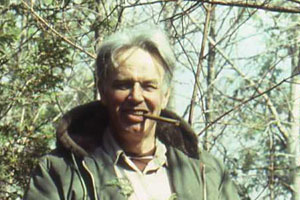 William A. Wimsatt (1917-1985) William A. Wimsatt (1917-1985)
Cornell University
1981 - NASBR 12 - Ithaca, NY
William A. Wimsatt (1917 –1985) was professor of Zoology and Chairman of the Department of Zoology at Cornell University well known for his pioneering research on the interrelationships of hibernation, energetics, and reproduction in the biology of bats. He was the editor of the widely acclaimed book series Biology of Bats. He also helped create the Annual North American Symposium on Bat Research, which later became NASBR. Wimsatt received his doctorate at Cornell under Howard Adelman, and he became an instructor of anatomy at Harvard Medical School in 1943. Two years later, he returned to Cornell as an assistant professor of zoology. In 1947, he was promoted to associate professor and in 1951, he was promoted to professor. From 1945 until 1960, Wimsatt taught courses in histology and embryology in the College of Arts and Sciences and also in the New York State College of Veterinary Medicine. Wimsatt made many research trips to the neotropics, but his most desired research trips were to the tropics of Mexico. In 1962, he spent a year working with Bernardo Villa after receiving a Guggenheim Fellowship. He spent three sabbatical leaves at the University of Arizona College of Medicine working with Dr. Philip Krutzsch, who shared similar research interests in reproductive biology of bats. Wimsatt’s primary expertise was on the functional morphology of placentae, and he used novel approaches in diverse areas of reproductive biology (e.g., embryology, placentation, and fetal membranes), physiology, hibernation, and how physiological traits linked to ecology. He was also as an Associate Editor of The American Journal of Anatomy, Director of the Cornell University Research Foundation, a Fellow of the American Association for the Advancement of Science, a member of the American Association of Anatomists, the American Society of Mammalogists, the Histochemical Society, the Society for the Study of Reproduction, and the American Society of Zoologists.

 Donald R. Griffin (1915-2003) Donald R. Griffin (1915-2003)
Rockefeller University
1979 - NASBR 10 - St. Louis, MO
Donald R. Griffin (1915 – 2003) received a G.S. Miller Award in 1979 in recognition for his outstanding work on the echolocation behaviour of bats. This focus of Griffin’s life and career nested well with his curiosity about animal orientation, and the continuity between humans and other animals. Griffin had done undergraduate and graduate work at Harvard University, held faculty positions at Cornell University, the Rockefeller Institute, and Princeton University and at Harvard. His book Listening in the Dark (1959) is an engaging story of his work on bats and echolocation. In 1944 he coined the term ‘echolocation.’ Griffin and his graduate students work on bats in both laboratory and field situations. He had a huge curiosity about animals and behaviour which is reflected by his published works. He often referred to echolocation as a ‘magic well’ because every time you visited the topic, you came away with more ideas. Do an experiment, or think of some very neat, new discovery about bat behaviour, and do not be surprised if Don had already written about it in Listening in the Dark. In 2002 he gave his last paper a NASBR at the meetings in Burlington, Vermont.

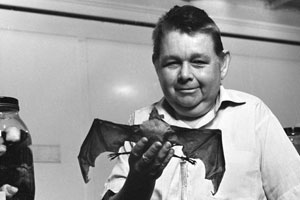 Karl F. Koopman (1920-1997) Karl F. Koopman (1920-1997)
American Museum of Natural History
1977 - NASBR 8 - Ottawa, ON
Karl Koopman was Curator of Mammals at the American Museum of Natural History in New York from 1961-1985, and continued as Curator Emeritus until his death at the age of 77 in 1997. He received all three of his academic degrees from Columbia University, beginning with the BA in 1943, MA in 1945, and Ph.D. in 1950. As a graduate student of Theodosius Dobzhansky, Karl wrote his dissertation on Drosophila genetics, demonstrating rapid reproductive isolation through natural selection in a paper still widely cited in genetics textbooks. Upon completing his Ph.D., he spent a year teaching at the Middletown Collegiate Center, and six years at Queen’s University in New York. In 1958 he moved to the Academy of Natural Sciences in Philadelphia, and a year later to the Field Museum in Chicago. Karl was very dedicated to the annual meetings of the American Society of Mammalogists (ASM) and to NASBR. He also attended all of the International Symposia on Bat Research, as well as the International Theriological Congresses. He published over 100 papers and suffice it to say that he had a better grasp on the evolutionary relationships within the entire order Chiroptera than anyone of his generation. Indeed, his classification of bats published in Mammal Species of the World (1993) and in the Handbuch der Zoologie (1994) forms the basis of all of our current work. At NASBR and all other scientific meetings, Karl assumed his familiar place in the front row of paper sessions, and gave his usual scholarly attention to every presentation. His incisive questions punctuated presentations by generations of students at scientific meetings for nearly half a century. In his earlier years, Karl did considerable fieldwork in the Caribbean and South America. The ASM honored Karl for meritorious service with the Hartley H.T. Jackson Award in 1988 and for his outstanding contributions to science by bestowing its highest honor, Honorary Membership, on him in 1990. NASBR accorded Karl its highest honor, the Gerritt S. Miller Award, in 1977. Karl attended every single bat meeting between 1971 and 1996, and was a frequent contributor to Bat Research News, where he published a series of summary papers on the families of bats.

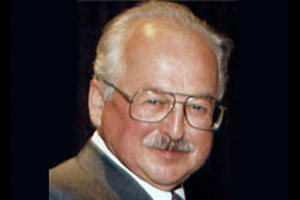 G. Roy Horst (1933 - 2023) G. Roy Horst (1933 - 2023)
State University of New York, Potsdam
1977 - NASBR 8 - Ottawa, ON
G. Roy Horst received the first G.S. Miller Award in 1977 at the bat meeting in Ottawa (Canada). He was a Professor Emeritus at State University of New York at Potsdam. After receiving his B.S. in Biology from Wagner College, Staten Island, NY, he completed his Ph.D. in Zoology from Cornell University with mentorship from William A. Wimsatt. After graduating from Cornell, he became an initial faculty member at the new University of Arizona Medical School in Tucson. He was a faculty member at the University of Vermont before moving to Potsdam NY. His doctoral dissertation and subsequent interests in bats focused on structure and function of the kidneys of the vampire bat, Desmodus rotundus. In addition to his interest in bats, he conducted field research in population ecology of mongooses in the West Indies. Roy was a catalyst and program director in organizing the initial “bat meeting”, the Southwest Symposium on Bat Research, in Tucson while at the University of Arizona in 1970. He became the sole Program Director and meeting organizer for the first 25 years of NASBR meetings. Roy retired as Program Director after NASBR 25, Boston (1995), but came back as a PD for NASBR 38 and 39, while NASBR was re-organizing and re-writing its constitution to become an official society, to help train the next generation of Program Directors. The NASBR Distinguished Service Award is named in his honor for his exemplary display of loyal service to the “bat meetings”.

|


 Craig Willis
Craig Willis

 Gerald Wilkinson
Gerald Wilkinson Tigga Kingston
Tigga Kingston Sharon Swartz
Sharon Swartz Betsy Dumont
Betsy Dumont James Simmons
James Simmons Elizabeth Kalko (1962-2011)
Elizabeth Kalko (1962-2011) Gareth Jones
Gareth Jones Wieslaw Bogdanowicz
Wieslaw Bogdanowicz Robert J. Baker (1942-2018)
Robert J. Baker (1942-2018) Nancy Simmons
Nancy Simmons R. Mark Brigham
R. Mark Brigham Rodrigo Medellin
Rodrigo Medellin Robert M. R. Barclay
Robert M. R. Barclay Patricia W. Freeman
Patricia W. Freeman Theodore H. Fleming
Theodore H. Fleming Gary F. McCracken
Gary F. McCracken Paul A. Racey
Paul A. Racey Don. E. Wilson
Don. E. Wilson Bernardo Villa-Ramirez (1911-2006)
Bernardo Villa-Ramirez (1911-2006) Merlin D. Tuttle
Merlin D. Tuttle Harold B. Hitchcock (1903-1995)
Harold B. Hitchcock (1903-1995) Thomas H. Kunz (1938-2020)
Thomas H. Kunz (1938-2020) M. Brock Fenton
M. Brock Fenton William A. Wimsatt (1917-1985)
William A. Wimsatt (1917-1985) Donald R. Griffin (1915-2003)
Donald R. Griffin (1915-2003) Karl F. Koopman (1920-1997)
Karl F. Koopman (1920-1997) G. Roy Horst (1933 - 2023)
G. Roy Horst (1933 - 2023)